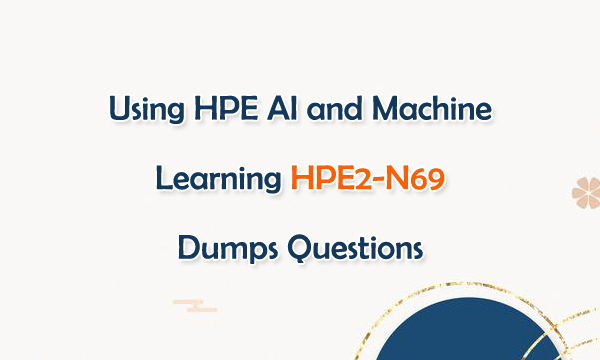Using HPE AI and Machine Learning HPE2-N69 Dumps Questions
November 01,2022 08:58 AM
Using HPE AI and Machine Learning HPE2-N69 dumps questions have been cracked, which are the latest version in the whole market. This HPE2-N69 exam tests the candidate's ability to display competency in the use of the HPE Machine Learning Development environment, including the ability to understand the challenges customers face in training Deep Learning models, describe how HPE Machine Learning Development Environment fits in the market, and design and use HPE Machine Learning Development Environment and System solutions. To prepare HP certification HPE2-N69 exam, the official HPE2-N69 exam information is helpful in the preparation.

HP Certification HPE2-N69 Exam
HP Certification HPE2-N69 exam basic information is available below.
Exam type: Web based
Exam duration: 1 hour 30 minutes
Exam length: 40 questions
Passing score: 65%
Delivery languages: English
HPE2-N69 Using HPE AI and Machine Learning Exam Objectives
Using HPE AI and Machine Learning HPE2-N69 exam objectives cover the following details.
Understand machine learning (ML) and deep learning (DL) fundamentals 24%
Articulate the business case for HPE Machine Learning Development solutions 13%
Describe the architecture for HPE Machine Learning Development solutions 15%
Demonstrate and explain how to use HPE Machine Learning Development Environment 33%
Engage with customers 15%
Practice HP Certification HPE2-N69 Exam Dumps Questions
All the latest HP Certification HPE2-N69 exam dumps questions are the best material for you to test all the above Using HPE AI and Machine Learning HPE2-N69 objectives. Share some HP Certification HPE2-N69 exam dumps questions and answer below.
1. A customer mentions that the ML team wants to avoid overfitting models. What does this mean?
A.The team wants to avoid wasting resources on training models with poorly selected hyperparameters.
B.The team wants to spend less time on creating the code tor models and more time training models.
C.The team wants to avoid training models to the point where they perform less well on new data.
D.The team wants to spend less time figuring out which CPUs are available for training models.
Answer: D
2. What are the mechanics of now a model trains?
A.Decides which algorithm can best meet the use case for the application in question
B.Adjusts the model's parameter weights such that the model can Better perform its tasks
C.Tests how accurately the model performs on a wide array of real world data
D.Detects Data drift of content drift that might compromise the ML model's performance
Answer: A
3. What distinguishes deep learning (DL) from other forms of machine learning (ML)?
A.Models based on neural networks with interconnected layers of nodes, including multiple hidden layers
B.Models defined with Apache Spark rather than MapReduce
C.Models that are trained through unsupervised, rather than supervised, training
D.Models trained through multiple training processes implemented by different team members
Answer: C
4. A company has recently expanded its ml engineering resources from 5 CPUs 1012 GPUs.
What challenge is likely to continue to stand in the way of accelerating deep learning (DU training?
A.A lack of understanding of the DL model architecture by the NL engineering team
B.The complexity of adjusting model code to distribute the training process across multiple GPUs
C.A lack of adequate power and cooling for the GPU-enabled servers
D.The requirement that the ML team must wait for the IT team to initiate each new training process
Answer: A
5. ML engineers are defining a convolutional neural network (CNN) model bur they are not sure how many filters to use in each convolutional layer. What can help them address this concern?
A.Using hyperparameter optimization (HPO)
B.Distributing the training across multiple CPUs
C.Using a variable learning late
D.Training the model on multiple epochs
Answer: D
HPE2-N69 Exam Dumps PDF & SOFT | 1 Year Free Update | Money Back Guarantee
- Related Suggestion
- HPE6-A41, HPE0-S37 and HPE0-Y53 exams are confirmed to be latest October 05,2017
- Pass HPE2-B04 Exam to Earn HPE Solution Certified - VMware Certification December 20,2024
- HPE2-B01 HPE Data Protection Solutions Exam Dumps Available November 01,2024
- HPE2-T38 Dumps: Path to Passing HPE AI and Machine Learning Exam October 21,2024
- HPE2-B02 Exam Dumps: Good Material for Earning HPE Solution Certified - Virtual Desktop Infrastructure Certification October 09,2024

